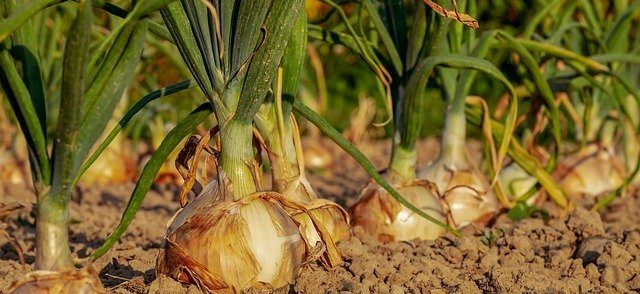With onions being the backbone of so many of the most delicious recipes, doesn’t it make sense to grow your own? Just think of all the dishes you could prepare with them: from curries to pasta sauces, soups and just eating them as nature intended as part of a salad or even after pickling them.
With the right advice, onions are not all that hard to grow. In fact, they’re actually relatively easy as long as you follow the right steps, so that’s why we put this article together for you, to guide you through the right process that’ll have you growing your own onions in no time.
Before planting onions
Before you rush into planting onions there are a few things to take care of first. At the top of the list should be deciding what variety of onion you would like. There are so many available to grow in the UK that I won’t bother listing them all here as it’ll take up too much space and time, but you should definitely research a little to find the best ones for you.
Another thing you need to decide on is whether you are going to plant seeds or go with small, immature onions, better known as sets. Growing from seeds will allow you a wider choice of onion varieties, but more work will be needed to plant and grow them. Sets are the easier choice and tend to be more reliable than seeds.
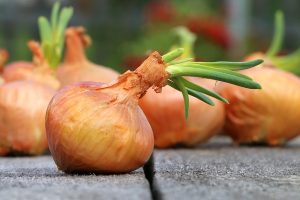
The last thing you need to do before planting onions is get the soil ready. In order to give your seeds or sets the best start possible, the soil needs to be well dug, and having a neutral pH level is definitely preferable. The soil should drain well and it is best to mix in compost and well-rotted manure in there prior to planting. If your soil retains too much water, it’s best to plant your onions in raised beds to help with drainage.
How to plant onions from seed
Planting from seed indoors can be a great way to get a head start on the growing process and can be started in late winter if done in a greenhouse.
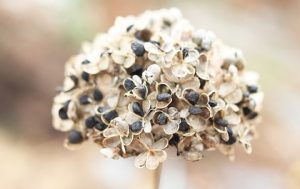
Sow the seeds into pots, or even module trays that have been filled with seed starting potting mix. Sow your seeds on top of the mix and then cover them with 1cm more of the potting mix. After this you should water lightly and keep this up until the seeds become seedlings and are ready to be transplanted into the ground.
When planting the seedlings, 10-15cm apart is ideal
If you’re going to plant the seeds directly into the ground soil, you need to do it in spring, as long as the ground has warmed and softened up enough. It is also possible to sow the seeds in late summer/early autumn but only if you have good soil that won’t get too soggy during autumn and winter.
After raking the soil, you need to make the seed drills about 30 cm apart from each other and 1cm deep. Like with the seedlings, cover with more soil and then water.
Other planting:
How to Plant Sunflower Seeds
How and when to plant strawberries in the U.K
How to water tomato plants
How to Grow in the Greenhouse All Year Round
Planting onion sets
If you’re going to plant sets, please get the heat-treated variety to prevent bolting which will make the onions inedible when you harvest them.
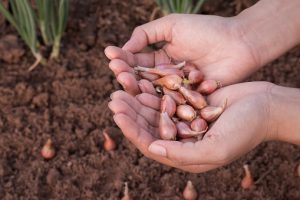
The best time to plant onion sets is mid-spring. Make sure you prepare the soil as we explained above, and do a good job of clearing away any weeds in the designated planting area.
Once the soil is ready, prepare some shallow drills and then sort out which of the sets you are going to plant. You should discard any sets that are too thin, and also ones that are too large or have patches on them.
Next, Insert the sets so that only the tips are showing above the soil, spaced about 10cm apart. Make sure that the root end is buried into the soil.
You should choose a spot that gets full or partial sun, and avoid growing in soil that has had similar crops such as leeks and garlic grown in it before.
When to harvest your onions
Late July and all of August is the best time to harvest your onions, but it might be ok to take one here and there a little earlier.
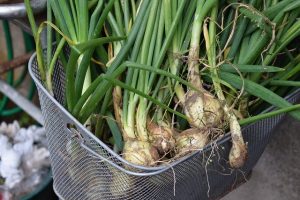
A good sign that your onions are ready to be harvested is if the stems are starting to bend and fall. Also keep a look out for the foliage changing to a more yellowish colour.
To ensure that your onions keep in storage for the optimal amount of time, they need to dry out properly after being picked, so try to harvest them during a spell of hot and dry weather.
Possible problems
While yellow foliage in August is a good sign of ripeness, at other times it can be a sign that there is a problem with onion fly larvae, especially if the foliage is looking unhealthy and drooping down.
Yellowing foliage can also be a sign of white onion rot, a fungus that will cause the roots to rot. This fungus is carried in the soil, and can be introduced into clean soil by using tools that haven’t been cleaned properly.
Too much watering, or particularly wet springs and summer periods can sometimes lead to neck rot on onions which is a type of mould.
There is also leek rust which, while not usually a big problem, can be if there is a large infection. This fungus causes bright yellow spots on the leaves but as we said, is usually harmless. The best way to tackle leek rust is, like many other fungal problems, don’t overcrowd your plants and try to avoid them being exposed to too much humidity.
